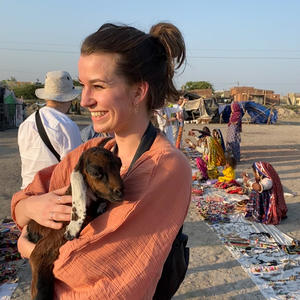International Women's Day: Inspiring Female Explorers
This International Women's Day, we're celebrating by looking back at some of the most inspiring female explorers in history and the incredible legacy they have left behind.
Egeria - 4th century
.jpeg)
Detailed letters written by pioneering Christian pilgrim Egeria - after she used the Bible as a guidebook to reach the Holy Lands from the Mediterranean - are sometimes referred to as the first travel memoirs in history. At the time, women’s writings were often considered more of an exercise in personal reflection, but Egeria's account of her travels conveys that she respectfully and sensitively inquired about local customs and traditions along her journey.
Gudrid Thorbjarnardottir - 9th century
.jpeg)
Gudrid Thorbjarnardottir, nicknamed the ‘far traveller’, was a young Icelandic explorer immortalised in Viking sagas. She was perhaps the most well-travelled woman of the Middle Ages and visited the Americas 500 years before Christopher Columbus did. There is evidence that she even settled and gave birth to her son there.
Jeanne Baret (1767-1807)
.jpeg)
The first woman to circumnavigate the globe was a French peasant and skilled ‘herb woman’. Baret’s extensive knowledge was noticed by the naturalist Philibert Commerçon, who hired her, and later became her lover. When he was chosen for a round-the-world expedition, he took Baret with him. She boarded the ship with her chest strapped, posing as a man. Commerçon was plagued by ill health on the journey, so Baret collected most of the plant specimens herself.
Sacagawea (1788 - 1812/1884?)
.jpeg)
At around 12 years old, Sacagawea, the daughter of a Shoshone chief, was kidnapped by a rival tribe and later sold to a French-Canadian trapper who married her. After the Louisiana Purchase, Thomas Jefferson sent Meriwether Lewis and William Clark to explore this unknown territory and recruited Sacagawea and her husband to help guide and translate. Sacagawea proved an invaluable member of the group at just 16 years old, not only because she brought knowledge of the terrain she had explored as a child and could communicate with the tribes they encountered, but she was able to forage food and plant medicine for the group. She even retrieved valuable supplies when one of their boats capsized. She gave birth to a son early on in their 8,000-mile journey and with her baby strapped to her, indicated peaceful intentions to any Native American tribes that their group encountered.
Mary Seacole (1805-1881)
.jpeg)
This British-Jamaican nurse was a global healer in the Victorian era and her passion for travel lead her to treat cholera patients in Panama and assist the injured on the frontlines of the Crimean War. She was affectionately known as ‘Mother Seacole’. Seacole had an entrepreneurial spirit and turned her hand at many business ventures over the years that were not always successful, but she eventually wrote her autobiography ‘Wonderful Adventures of Mrs Seacole in Many Lands’ which was a great success and was one of the first travel memoirs ever published by a black woman. In 2004, people voted Seacole the ‘Greatest Black Briton’.
Emma Gatewood (1887-1973)
.jpeg)
Nicknamed the ‘Hiking Grandma’ (she was actually a great-grandma), mother to 11 children and survivor of domestic violence, Gatewood was the first woman to hike all 2,190 miles of the Appalachian Trail by herself, in one season, at the age of 67. She conquered the trail two more times, as well as the 2000-mile Oregon Trail.
Bessie Coleman (1892-1926)
.jpeg)
Bessie became the first African American woman and Native American to be awarded a pilot's license. Rising above racial and gender prejudices of the time, Bessie fought against the odds - she walked miles to attend school, paid for her tuition working in cotton fields and was refused a place in aviation school in America. So she went to France, where she learnt to fly at the age of 21. She went on to travel through the US performing aerial stunts and refused to perform at venues with segregated crowds.
Junko Tabei (1939–2016)
.jpeg)
Junko Tabei founded the ladies' climbing club in Japan in the sixties, breaking into the highly-masculine sphere of mountaineering. She was the first woman to summit Everest, and the highest mountain on every continent (known as the Seven Summits). Not only did she cultivate an environment to support female climbers, but she also helped protect and preserve the environment by leading ‘clean-up climbs’ all over the world.
Namira Salim (1975- )
.jpeg)
Born in Karachi, Salim has quite a few ‘first’ titles under her belt. She was the first Pakistani to reach the North Pole, followed by the South Pole a year later, where she hoisted flags for Pakistan and peace. She was the first Asian to skydive Mount Everest and will be the first Pakistani space tourist on Virgin Galactic's future commercial space liner. As if that’s not enough, she was also awarded the Power 100 Trailblazer Award by Pakistan Power 100 in London in 2013 for her efforts to promote international peace and harmony, and she even found time to release a single, Follow Me To The Moon. Of course.
